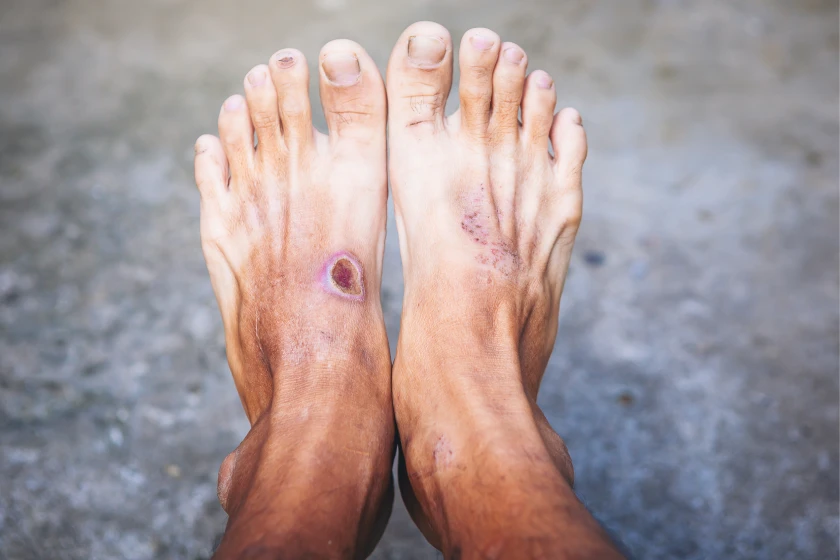
It often starts as a tiny wound that most people ignore. A scratch, a minor cut, or even a blister on the leg that does not seem serious. For many, particularly those living with diabetes or poor circulation, these minor injuries can evolve into a serious medical condition called a leg ulcer. A leg ulcer is an open sore on the skin that fails to heal and can persist for weeks or months.
In India, diabetic leg ulcers are increasingly common. Studies suggest that nearly 15% of people with diabetes may develop foot or leg ulcers at some point in their lives. These ulcers are not just superficial wounds; they can signal underlying vascular problems, poor circulation, or infection.
Delaying medical attention can lead to severe complications, including chronic pain, reduced mobility, and, in extreme cases, amputation.
Understanding the warning signs of a leg ulcer and seeking timely medical care is crucial. A small wound, if treated early, can heal completely. Ignoring these signs, however, can turn a minor injury into a major health concern.
Common Signs That Need Immediate Medical Attention
Not every sore on the leg requires urgent care, but certain warning signs should never be ignored. Recognizing these symptoms early can prevent serious complications:
- Persistent non-healing wound: If a sore remains open for more than two weeks, it may indicate poor blood flow, infection, or diabetes-related complications
- Pain, tenderness, or swelling: Worsening discomfort around the ulcer or swelling in the leg can suggest inflammation or vascular obstruction.
- Discoloration of skin: The area around the ulcer may appear red, brown, purple, or black. This is often a sign of tissue damage or poor circulation.
- Pus or foul odor: Discharge or an unpleasant smell indicates infection. Immediate medical care is necessary to prevent the spread of bacteria.
- Thickened, scaly, or itchy skin: Chronic irritation and poor circulation may cause the skin to change in texture or thickness.
- Fever or general malaise: Fatigue, fever, or chills can indicate that the infection is spreading beyond the skin, which is a medical emergency.
Ignoring these signs can allow a simple wound to worsen rapidly. Early recognition and intervention can mean the difference between quick healing and severe complications.
Types and Causes of Leg Ulcers
Leg ulcers can occur for a variety of reasons, and identifying the type helps determine the best treatment. The most common types include:
- Venous ulcers: These are caused by poor blood flow in the veins, often due to varicose veins or chronic venous insufficiency. They typically appear above the ankle and are accompanied by swelling and aching.
- Arterial ulcers: These ulcers result from reduced blood flow through the arteries, often due to atherosclerosis or peripheral artery disease. They are usually painful, with a punched-out appearance, and may appear on the toes, feet, or lower leg.
- Diabetic ulcers: Diabetic patients are at high risk due to nerve damage (neuropathy) and poor circulation. These ulcers are often painless but prone to infection and slow healing. They usually develop on pressure points like the soles of the feet.
- Pressure ulcers: Also known as bedsores, these occur in individuals who are bedridden or immobile for long periods. They develop due to prolonged pressure on certain areas, reducing blood flow and damaging the skin.
- Mixed ulcers: Some ulcers may have combined causes, for example, diabetes with venous insufficiency. Understanding the underlying cause is crucial for effective treatment.
When to See a Doctor Immediately
If your leg ulcer shows any of the warning signs mentioned earlier, it is crucial to see a doctor immediately. Diabetic patients need to be especially vigilant because nerve damage can mask pain, and infections can progress rapidly.
A leg ulcer doctor or vascular surgeon will conduct a thorough examination to determine the cause. Diagnostic tests may include:
- Blood tests to check sugar levels and infection markers
- Doppler ultrasound to assess blood flow in veins and arteries.
- Imaging tests to identify blockages or damage in the vascular system
Early evaluation allows doctors to tailor the treatment. For example, a venous ulcer may require compression therapy and wound care, while an arterial ulcer may need vascular intervention to restore blood flow. Timely medical attention can prevent the ulcer from becoming chronic and reduce the risk of complications like gangrene or osteomyelitis.
Possible Complications if Ignored
Left untreated, leg ulcers can lead to serious consequences:
Infection: Open sores provide a pathway for bacteria, which can cause cellulitis or abscess formation. In diabetic patients, these infections spread faster and are harder to treat.
Gangrene: Poor circulation can lead to tissue death, sometimes requiring amputation to prevent further complications.
Osteomyelitis: The infection can spread to the underlying bone, causing chronic pain and long-term disability.
Sepsis: Rare but severe, sepsis occurs when infection enters the bloodstream, becoming life-threatening.
Reduced mobility: Chronic ulcers are painful and can affect daily activities, impacting the patient’s quality of life.
Psychological impact: Persistent ulcers can cause stress, anxiety, and social withdrawal due to discomfort and limited mobility.
Modern Treatment Options
Treatment of leg ulcers depends on the type and severity. The goal is to promote healing, manage infection, and prevent recurrence. Common treatment strategies include:
Wound care and dressing: Regular cleaning and specialized dressings keep the ulcer protected and promote healing. Advanced dressings with antibacterial properties can help control infection.
Medications: Antibiotics treat infection, while other medications may improve circulation or control underlying conditions such as diabetes or high blood pressure.
Compression therapy: For venous ulcers, medical-grade compression stockings or bandages help improve blood flow and reduce swelling.
Lifestyle modification: Controlling blood sugar, following a balanced diet, staying active, and maintaining leg hygiene are essential for healing.
Vascular surgery: In severe cases, when circulation is compromised, vascular interventions such as angioplasty, bypass surgery, or endovascular procedures may be required to restore blood flow and promote healing. These procedures are especially important for arterial or diabetic ulcers that do not respond to conventional care.
Offloading pressure: For diabetic foot ulcers, reducing pressure on the affected area with special footwear or orthotics helps prevent ulcer worsening.
Advanced Wound Healing methods: We regularly use natural or synthetic dermal matrix or substitutes to cover complex ulcers where the tendon or even bone is exposed. These matrices (Matriderm, Myriad, BTM, etc) are used to cover such wounds along with Negative Pressure Wound Therapy or NPWT.
Hyperbaric Oxygen Therapy
HBOT is a scientifically proven method to improve tissue oxygenation by 4 to 6 times, when the patient breathes 100% oxygen under higher atmospheric pressure in closed acrylic chamber.
Preventive Care and Self-Management Tips
While medical treatment is essential, preventive measures play a significant role in avoiding leg ulcers or preventing them from worsening:
- Inspect legs daily for cuts, blisters, or discoloration.
- Keep legs clean and dry, and change dressings as instructed.
- Avoid tight footwear or clothing that causes friction.
- Elevate legs while resting to reduce swelling and improve circulation.
- Stay active to improve blood flow.
- Manage blood sugar levels strictly in diabetic patients.
- Consult a vascular specialist regularly for routine checks.
Preventive care, combined with prompt medical intervention, ensures faster healing, reduces the risk of recurrence, and improves overall leg health.
Conclusion
A leg ulcer is more than just a sore on the leg. It is often a visible sign of underlying circulatory issues, diabetes-related complications, or infection. Even a small wound, if ignored, can escalate into chronic ulcers, infections, or, in severe cases, gangrene and amputation.
Early recognition of warning signs and timely consultation with a leg ulcer doctor or vascular specialist is critical. Modern treatments, including advanced wound care, medications, compression therapy, and vascular interventions, have made it possible for even chronic or severe ulcers to heal effectively.
Dr. Sumit Kapadia, a leading vascular surgeon, emphasizes a personalized approach to treatment, addressing the root cause of the ulcer rather than just the wound. With proper care, early diagnosis, and expert guidance, patients can heal faster, prevent complications, and maintain their mobility and quality of life.
Frequently Asked Questions
Signs include increased pain, swelling, redness, pus discharge, foul smell, and sometimes fever or chills.
If a wound does not heal within two weeks, changes in color or appearance, or shows signs of infection, it is important to consult a doctor immediately.
Ignoring a leg ulcer can lead to severe infection, tissue death, gangrene, and, in extreme cases, amputation.
Maintain blood sugar control, keep legs clean and dry, inspect them daily, avoid tight footwear, elevate the legs, and seek timely medical care.
Yes. In cases of poor circulation or arterial blockages, vascular interventions can restore blood flow and support ulcer healing.

Dr. Sumit Kapadia
MBBS, MS, MRCS, DNB-Fellow



